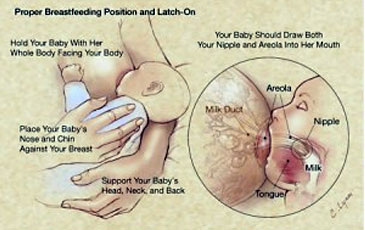- Breast milk is the perfect food for babies. Not only does breast milk have the right nutritional balance for your baby, but it also contains growth factors, antibodies, and other mechanisms that protect your baby against infections
- Breastfed babies have fewer illnesses, infections and allergies.
- They have a lower risk of obesity in their
- Breastfeeding helps bonding between mother and the baby.
- WHO recommends Exclusive breastfeeding (Only breastfeeding and not even water) for six months.
- After 6 months infants should receive complementary foods with in addition to breastfeeding up to two years of age or even beyond 2 years
When to start Brest feeding?
Newborn babies should be put on breast within half an hour of birth
How often I need to breastfeed?
Your newborn baby may feed frequently, every one-and-a-half to three hours for the first few days to stimulate your breasts to produce more milk volume.
How would I know my baby is hungry?
Whenever your baby shows signs of waking or hunger, like mouthing movements or placing his hands to his mouth, he/she should be put to the breast.
What should I do if the baby cry vigorously while feeding?
Try to put your baby to the breast before he/she starts to cry vigorously, because he will not be able to concentrate on breastfeeding while upset. Allow your baby to suck on your (well-washed) finger until he/she settles, then try to put him/her on your breast once again.
Which breast do I need to use for feeding?
Alternate the breast at each feed, and allow your baby to nurse as long as he wants on the first breast, so that he can receive more of the calorie-rich hind milk.When to change the breast while feeding?
You can stop the breastfeeding if your baby has finished the first breast when his suckling slows and you don’t hear swallowing. Give your baby a short break, then offer the second breast. Allowing your baby to suckle on both breasts at each feeding will help to establish your milk supply. Remember that Mothers with large milk supplies may only need to offer one breast per feed.
How to ensure good breast milk supply?
Frequent and routine removal of the milk from the breast ensures good breast milk supply.
How many times do I need to breastfeed?
Generally baby needs about eight feedings per day to gain weight properly.
What happens if I don’t feed the baby regularly?
If feedings are delayed or the breast isn’t emptied at a regular feeding time, the breast will become full and uncomfortable. This pressure in the breast will send a message that your baby don’t want this milk and will reduce the milk production.
What is the proper way to feed the baby (Latch on )?
- Hold your baby in a comfortable position across your chest, or upright sitting on your hip, so that his face is directed toward your breast.
- Support your breast with your free hand when getting him to latch on.
- It may be helpful to express or massage some breast milk down to the nipple for your baby to taste or lick before you get a wide open mouth to latch.
- When he opens wide, bring him quickly but gently towards your breast.
- Do not push your breast towards your baby.
- Your baby’s chin comes first, with the lower lip covering as much of the brown area of the breast, called the areola, as possible.
- The upper lip comes to the breast last.
- Remember - Your baby should not just suckle on the nipple alone because this will cause discomfort and poor milk transfer.
- If your baby has not latched on properly and is causing discomfort, insert your finger into the corner of his mouth through the gums to break the suction and remove him from your breast.
- Reposition and re-latch until you feel comfortable.
- It may take a few moments of initial rapid suckling until you hear your baby start to swallow your milk and then the sucking slows down as he continues to drink your milk.
Cradle position:
- This is a good position after you are comfortable with breastfeeding.
- Your baby lies in your lap with her head held in the crook of your arm.
- The baby’s chest should be against your chest so that she doesn’t have to turn her head to reach your nipple.
- Some mothers find it hard to guide their newborn’s mouth to the nipple with the Cradle Hold.
- So you may consider using this position when your baby has stronger neck muscles at about 1 month old.
- Women who have had a cesarean section may find it puts too much pressure on their abdomen.
Cross-Cradle Position:
- In this position, the breast is held by the arm on the same side (the left breast is held by the left hand). The Cross-Cradle position gives the mother more control in guiding their baby’s mouth to the nipple. Mothers who have had a cesarean section may find this positon, to puts too much pressure on their abdomen.
Football Position:
- This position also works well when you are learning to breastfeed or if you have flat or sore nipples, or if you have had a caesarean birth and can’t place the baby on your stomach.
- This position also provides good control in guiding the baby’s mouth to the nipple.
- It also works well for women who have large breasts or flat nipples, and for mothers of twins.
Lying down:
- Lying on your side, place the baby on her side facing you, with her head at your breast.
- This position is ideal for night feeding because it allows both you and the baby to rest.
- This is also a good position if you find it too painful to sit, have large breasts, or if you have had a caesarean section.
How to breastfeed after a caesarean section?
- Breastfeeding while lying on your side with a pillow behind your back and one underneath your baby might help rise the baby to the breast level and make you feel comfortable and less painful.
- You can also use football hold position if you prefer to sit while feeding.
How to breastfeed a premature baby?
- Support your premature baby’s head and hold your baby across your chest and facing your breast for first introductions to the breast.
- Premature babies will attempt to lick the milk from the end of the nipple and open their mouths just like term babies.
- Depending on the size of your nipple area, it might not be possible for your baby to latch for several weeks until he grows.
- Feeding the expressed breast milk could be done till your premature baby learns to latch well and feed.
How to breastfeed the twin babies?
- The easiest way to nurse twins at the same time is to use the football position for both babies.
- Alternate breasts to maintain a good milk supply in both breasts.
How to know whether my baby is getting enough milk?
-
You are producing enough milk if you notice the following in your baby
- Voids urine 6 or more times per day
- Seems content after each feeding.
- Gaining weight
(Generally newborn babies loose weight in the first week of life and then they start-gaining weight. By the end of second week they should reach the birth weight again)
All babies do cry occasionally and this is not an indicator of inadequacy of breast milk.
Why do babies some times feel hungry and demand frequent feeds?
At about 3 weeks, 6 weeks, and 10 to 12 weeks, you may experience days when your baby continually wants to eat. This is caused by a growth spurt and they demand more milk volume. For about 2 days, your baby will feed frequently (some times every ½ hour) until your body responds with more milk volume and then your feeding routine generally returns to normal. This is not the time to give your baby extra bottles of formula as this will reduce your milk supply rather than increase it.
Does my child need Additional vitamins?
Breast milk provides all the vitamins and minerals your baby needs, except for some vitamins like vitamin D. All breastfed babies need an additional supplement of vitamins.
Do I need to Supplement my baby with formula?
The first few weeks after birth are the most important in terms of establishing your milk supply. Therefore, try not to offer your baby any supplemental bottles during that time. If your baby is not gaining weight properly, ask your doctor about it.
Can I Take medications while breastfeeding?
Most drugs can be transferred to a baby through breast milk. However, most medications that reach the breast milk do so in very small quantities. This means that a baby will receive only tiny amounts of the drug. If you need to take a medication while breastfeeding, check with your doctor to make sure that the medication is compatible with breastfeeding.
Do I need to use Breast pump?
You may need to express your breast milk for many reasons:
- To make latching easier by softening the breast,
- To relieve breast engorgement,
- To stimulate more milk production,
- To freeze extra milk for returning to work or a night out, or
- To feed a premature or sick baby.
Milk can be expressed by hand, by gently and rhythmically squeezing the milk out of the breast, but it can also be expressed by a manual or electric breast pump.




